Backing Up
Printing the second side of a sheet of paper.
Bleed
The area of artwork that extends beyond the finished size of a document (usually 3mm on all edges). After the document is printed and trimmed to the final size the print will reach right to the very edges of the page.
Blind Debossing
Stamping a design onto the front of an unprinted area of paper or card to produce a sunken in effect.
Blind Embossing
Stamping a design onto the reverse of an unprinted area of paper or card to produce a raised effect.
Board
Material up to and including 170gsm is referred to as paper. Material over 170gsm is referred to as board.
Burst Binding also called Slot Binding
Similar to perfect binding. Before gluing, large slots are cut into the spines of each section to allow the adhesive to glue the paper in each section and then all the sections together. The cover is drawn on. It will have a squared off spine.
Bulk
The thickness of paper or board. Measured in microns.
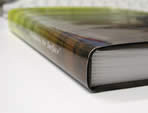
 Case Binding
Case Binding
A book bound with a stiff, hard cover that is covered by fabric or other material. In case binding, most often used in book production, a minimum of 60 printed sheets are folded into 16 or 32-page signatures, which are collated and sewn by machine.
The sewn edges are coated with glue. Then a strip of gauze adheres to the document's spine. Finally, the book and its covers are placed in a casing-in machine, which pastes the endpapers and fits the cover.
Chain of Custody
The Chain of Custody certification process traces forest products through the supply chain to the end-consumer.
Closed-Gate Fold
A fold where the two side edges of a sheet are folded in towards the middle (but leaving a small gap) and then folded in half again
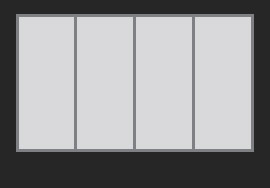 |
Hover mouse over
image to animate |
Coating
A liquid applied as the final process on the press which seals the ink so it dries really hard and does not set off or cause the sheets to snag in any finishing machinery.
Concertina Fold also called Accordian Fold or Zig Zag Fold
Two or more parallel folds applied to a document to give the appearance of a concertina.
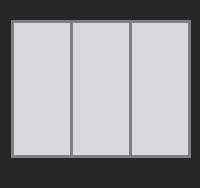 |
Hover mouse over
image to animate |
Crease
A score line put on heavy paper and board to help it to fold and to reduce cracking.
Cutting Forme
A template made from sharp metal lines (rules) embedded in a wooden base which is used to die cut documents to an irregular shape or to cut shapes out of printed sheets. Blunt rules are used to create creasing lines.
Cracking
When board is folded you may notice that the board starts to break or crack at the fold. To reduce this boards are always creased before they are folded.
Crop Marks
Special marks added to artwork outside the area to be printed to show where the job should be trimmed to achieve the required finished size.
Debossing
Stamping a design onto the front of a printed area of paper or card to produce a sunken in effect.
Die Cut
Paper or board can be die cut to an irregular shape or have a shape cut out of the middle using a cutting forme. (Imagine making biscuits using a pastry cutter.) Creases can also be added to help a document fold.
Drawn On Cover
A paperback cover which is attached to the text pages by gluing the spine.
Dust Jacket
An outer paper cover (usually printed and laminated) which is wrapped around the outside of a book. Most often seen with case bound books.
Embossing
Stamping a design onto the reverse of a printed area of paper or card to produce a raised effect.
Finished Size
The size of the job once it is completely finished. It is a standard convention to write the size of the document giving the height or spine measurement first.
Flat Size
The size of the job once it is trimmed but before it is folded. An A4 4pp leaflet has a flat size of A3.
Four Colour Process
Just as a computer screen combines Red, Green & Blue light to display millions of colours, printers can combine just four standard ink colours to reproduce thousands of colours. These four colours are Cyan, Magenta, Yellow and Black (CMYK). If you look at a four colour process job under an eyeglass you can see patterns of dots of each colour which together give the overall effect required.
Forest Stewardship Council (FSC)
The Forest Stewardship Council is an independent, non-governmental, not for profit organisation established to promote the responsible management of the world's forests. (more)
Full Colour
Another term to describe four colour process.
gsm
This stands for "grams per square metre" and is the standard unit of weight for paper.
Grip
This refers to a small strip along one long edge of a sheet of paper which cannot be printed on as the printing press grips this edge to pull the paper through the press.
Keyline
The artwork required for producing a cutting forme.
Lamination
A gloss or matt clear plastic film which is added after printing. As well as providing a pleasing effect it will add some durability.
Landscape
When a document is wider than it is tall it is referred to as landscape.
Leaf see also Page
A single side. 1 leaf is equivalent to 2 pages.
Lined-on
There is a limit to the thickness of card that can be printed on a litho press. In order to achieve a thicker result a (usually printed) sheet of paper is glued to a piece of thicker card. This is often seen on the covers of case bound books.
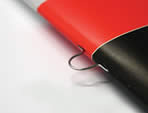 Loop Stitching
Loop Stitching
A method of saddle stitching whereby the stitch is formed into a semi-circular loop that sticks out beyond the spine of the publication. These loops slip over the rings of a binder, serving as an alternative to hole punching.
Microns (mic)
The measurement of the thickness of a sheet of paper or board. 1 micron = 0.001mm
Open-Gate Fold
A fold where the two side edges of a sheet are folded in towards the middle (but leaving a small gap).
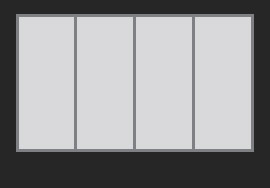 |
Hover mouse over
image to animate |
Page see also Leaf
A single side of a sheet.
Paper
Material up to and including 170gsm is referred to as paper. Material over 170gsm is referred to as board.
PEFC see Programme for the Endorsement of Forest Certification
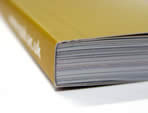 Perfect Binding
Perfect Binding
Perfect binding is well suited for use with books, thick magazines, annual reports, technical manuals, and catalogues. From a minimum thickness of approximately 3mm, it works well with a wide range of document thickness and trim sizes.
To produce a perfect-bound document, the folded signatures are gathered together in page sequence, clamped together, and placed in a machine that slices about 3mm off their left edges. Then roughers mill the newly sliced sheet edges to prepare them for gluing. Finally, the edges receive an adhesive application and adhere to a backing.
Although text pages printed on 170gsm material can be perfect bound, we do not recommend using material heavier than 150gsm as the document is liable to fall apart.
PMS
Stands for Pantone Matching System and usually followed by a 3 or 4 digit reference code e.g. PMS 032 which is a shade of red. Pantone colours are the standard ink colours used when printing spot colours.
Portrait
When a document is taller than it is wide it is referred to as portrait.
Programme for the Endorsement of Forest Certification
The PEFC Council is an independent, non-profit, non-governmental organisation which promotes sustainably managed forests through independent third party certification. The PEFC provides an assurance mechanism to purchasers of wood and paper products that they are promoting the sustainable management of forests.
It is a global umbrella organisation for the assessment and mutual recognition of national forest certification schemes developed in a multi-stakeholder process. These national schemes build upon the inter-governmental processes for the promotion of sustainable forest management, a series of on-going mechanisms supported by 149 governments in the world covering 85% of the world's forest area. (more)
Printed-laminated covers
A style of cover used on a case bound book. The cover artwork is printed onto one side of a sheet of paper (usually 150gsm) then laminated on the printed side. The resulting cover is then lined-on to a thick board to created the finished hard case (or cover).
Punch Out see Die Cut
Registration Marks
Special marks (usually a crosshair with a circle) added to artwork outside the area to be printed to help printers ensure that each colour to be printed will line up properly with all other colours being printed on the same sheet.
Roll Fold
Two or more parallel folds starting from one edge and rolling in. For multiple folds the innermost panels are reduced in width to allow the finished document to sit nicely.
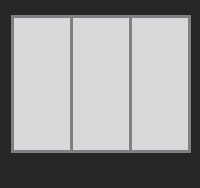 |
Hover mouse over
image to animate |
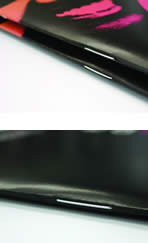
 Saddle Stitching
Saddle Stitching
Most booklets, magazines, catalogues and many other printed documents are bound using saddle stitching.
Wire staples hold the pages together. A machine drives them through its backbone fold to the centrefold, where they clench. A saddle-stitched printed piece lies almost flat when opened, a convenience for readers.
However, saddle stitching involves certain mechanical requirements. A saddle-stitched document must be at least eight pages long and increase in length in four-page increments. Saddle stitching is a good choice for binding documents of up to 64-80 pages. Documents involving more pages or heavy material may demand some other type of binding.
Self Cover
When the cover of a booklet is printed on exactly the same material as the text pages it is called a self cover.
Set Off
After printing, the sheets need a while for the ink to dry. If you process them too soon you can find that the printed image from one sheet has transferred to the reverse of the sheet above. This is known as set off. Applying a coating during printing helps avoid this.
Slot Binding also called Burst Binding
Similar to perfect binding. Before gluing, large slots are cut into the spines of each section to allow the adhesive to link the paper in each section and the sections to each other. The cover is drawn on. It will have a squared off spine.
Spot Colour
A single ink colour, that can either be printed as a solid or as a percentage tint to create a paler effect.
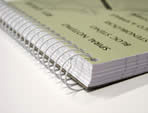 Spiral Binding
Spiral Binding
Spiral bindings cost somewhat more than Wire-o. They may be made of either plastic or wire and allow the printed document to lie flat and to double over, useful characteristics for documents such as technical manuals, notebooks, and calendars.
One cannot add pages to documents once they are spiral bound. Also, rough handling may crush the spirals.
Spot Gloss UV Varnish
Adds a high gloss sheen to a specific area of print e.g. a company logo, photograph or document title. Usually added on top of a matt lamination for maximum contrast.
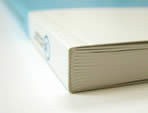
 Thread Sewn
Thread Sewn
Mainly used in book production requiring more durability than perfect binding.
Printed sheets are folded into signatures which are collated and sewn by machine. Adhesive is then applied to the spine and the cover is drawn on.
UV Varnish see Spot Gloss UV Varnish
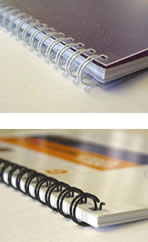
 Wire-o Binding
Wire-o Binding
Typically used to bind reference books, reports, proposals, and calendars. They are durable, but do not permit printing on the document spine or the insertion of new pages.
A Wire-O binding holds the covers and pages of a document firmly in place by a double-loop wire inserted through holes drilled in their left edges.
All of the document's pages lie flat when opened, can turn easily through 360 degrees.
